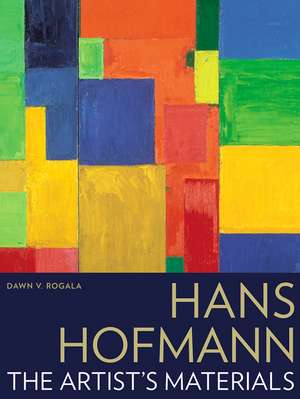Hans Hofmann: The Artist’s Materials: The Artist's Materials
Autor Dawn V. Rogalaen Limba Engleză Paperback – 3 oct 2016
The career of the German-American painter and educator Hans Hofmann (1880–1966) describes the arc of artistic modernism from pre–World War I Munich and Paris to mid-twentieth-century Greenwich Village.
His career also traces the transatlantic engagement of modern painting with the materials of its own making, a relationship that is perhaps still not completely understood. In these interrelated narratives, Hofmann is a central protagonist, providing a vital link between nineteenth- and twentieth-century art practice and between European and American modernism. The remarkable vitality of his later work affords insight not only into the style but also the literal substance of this formative period of artistic and material innovation.
This richly illustrated book, the fourth in the Getty Conservation Institute’s Artist’s Materials series, presents a thorough examination of Hofmann’s late-career materials. Initial chapters present an informative overview of Hofmann’s life and work in Europe and America and discuss his crucial role in the development of Abstract Expressionism. Subsequent chapters present a detailed analysis of Hofmann’s materials and techniques and explore the relationship of the artist’s mature palette to shifts in the style and aging characteristics of his paintings. The book concludes with lessons for the conservation of modernist paintings generally, and particularly those that incorporate both traditional and modern paint media.
This book will be of value to conservators, art historians, conservation scientists, and general readers with an interest in modern art.
His career also traces the transatlantic engagement of modern painting with the materials of its own making, a relationship that is perhaps still not completely understood. In these interrelated narratives, Hofmann is a central protagonist, providing a vital link between nineteenth- and twentieth-century art practice and between European and American modernism. The remarkable vitality of his later work affords insight not only into the style but also the literal substance of this formative period of artistic and material innovation.
This richly illustrated book, the fourth in the Getty Conservation Institute’s Artist’s Materials series, presents a thorough examination of Hofmann’s late-career materials. Initial chapters present an informative overview of Hofmann’s life and work in Europe and America and discuss his crucial role in the development of Abstract Expressionism. Subsequent chapters present a detailed analysis of Hofmann’s materials and techniques and explore the relationship of the artist’s mature palette to shifts in the style and aging characteristics of his paintings. The book concludes with lessons for the conservation of modernist paintings generally, and particularly those that incorporate both traditional and modern paint media.
This book will be of value to conservators, art historians, conservation scientists, and general readers with an interest in modern art.
Preț: 229.48 lei
Preț vechi: 274.28 lei
-16% Nou
Puncte Express: 344
Preț estimativ în valută:
43.92€ • 47.73$ • 36.92£
43.92€ • 47.73$ • 36.92£
Carte indisponibilă temporar
Doresc să fiu notificat când acest titlu va fi disponibil:
Se trimite...
Preluare comenzi: 021 569.72.76
Specificații
ISBN-13: 9781606064870
ISBN-10: 1606064878
Pagini: 160
Ilustrații: 55 color and 17 b-w illustrations
Dimensiuni: 191 x 254 x 13 mm
Greutate: 0.5 kg
Ediția:1
Editura: Getty Publications
Colecția Getty Conservation Institute
Seria The Artist's Materials
ISBN-10: 1606064878
Pagini: 160
Ilustrații: 55 color and 17 b-w illustrations
Dimensiuni: 191 x 254 x 13 mm
Greutate: 0.5 kg
Ediția:1
Editura: Getty Publications
Colecția Getty Conservation Institute
Seria The Artist's Materials
Notă biografică
Dawn V. Rogala is a paintings conservator in the Museum Conservation Institute at the Smithsonian Institution in Suitland, MD.
Recenzii
“Rogala provides an important piece of scholarship that keenly navigates the challenges of integrating these two fields [art history and science] all the while maintaining a surprisingly accessible and enjoyable tone.”








